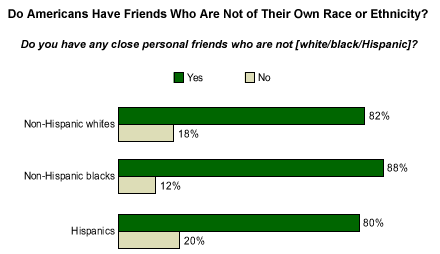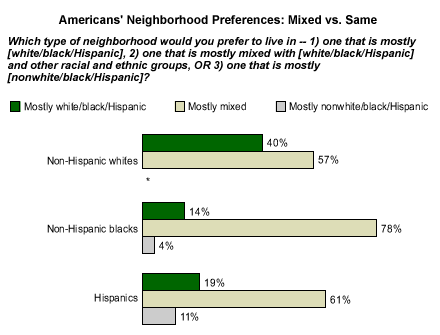If America is a "nation of nations," then it appears that most of its citizens -- especially those in the two largest minority groups -- are willing to embrace this diversity in their circle of close friends and neighbors.
A majority of respondents to a recent Gallup Poll on civil rights, sponsored by AARP and the Leadership Conference on Civil Rights*, report that they have close personal friends from racial or ethnic backgrounds different from their own. As well as having friends of different races and ethnicities, most Americans prefer to live in mostly mixed neighborhoods, rather than in neighborhoods inhabited only by those of their same race or ethnicity.
Blacks, Hispanics, and whites are likely to say they have friendships with people who do not share the same racial or ethnic backgrounds:
- 88% of blacks report having close personal friends who are not
black.
- 80% of Hispanics say they have close personal friends who are
not Hispanic.
- 82% of whites say they have close personal friends who are not white.

In terms of community, most Americans say they'd prefer to live in a neighborhood that is racially and ethnically mixed, rather than one that is homogeneous. Black Americans, in particular, express this preference, with approximately three-quarters (78%) reporting that they prefer to live in a neighborhood that is mostly mixed with black and other racial and ethnic groups. Only 14% of blacks would prefer to live in a neighborhood that is mostly black, and only 4% would choose to live in a neighborhood that is mostly nonblack.
Hispanics are similar to blacks in their preferences for neighborhood types, although somewhat fewer Hispanics would prefer living in a mixed neighborhood. Approximately 6 in 10 (61%) Hispanics prefer to live in a neighborhood that is mixed with Hispanics and those of other races and ethnicities. About a fifth (19%) prefer to live in a neighborhood that is mostly Hispanic, while 11% would favor living mostly among non-Hispanics.
A majority of whites (57%) also share the desire to live in a mixed neighborhood, but a substantial minority(40%) would prefer a mostly white neighborhood, and less than 1% would prefer to live among mainly nonwhites.

*The AARP/Gallup poll results are based on telephone interviews with 2,002 adults, aged 18 and older, conducted between Nov. 11-Dec. 14, 2003. For results based on the total sample, one can say with 95% confidence that the margin of sampling error is ±5 percentage points.
For results based on the 446 national adults who identify as African American/black -- but not Hispanic, the maximum margin of sampling error is ±8.5 percentage points.
For results based on the 915 national adults who identify as white -- but not Hispanic, the maximum margin of sampling error is ±6.7 percentage points.
For results based on the 551 national adults who identify as Hispanic -- including those who identify as white or black or other, the maximum margin of sampling error is ±6.2 percentage points.
In addition to sampling error, question wording and practical difficulties in conducting surveys can introduce error or bias into the findings of public opinion polls.
